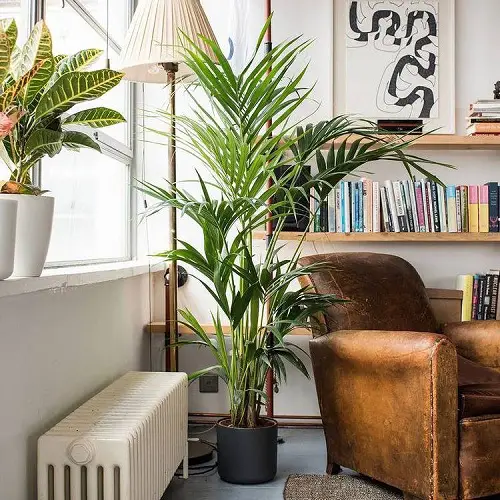Growing Areca Palm Indoors can be quite rewarding if you follow the right steps, and the plant will continue to thrive for a long time!
Transform your indoor spaces into tropical sanctuaries with the beauty of Areca Palms. Let us delve into the art of successfully growing and caring for these graceful and vibrant houseplants. Discover the secrets to Growing Areca Palm Indoors and creating a lush oasis inside your home.
Botanical Name: Dypsis lutescens
USDA Zones: Areca Palm growing zone is 9-11
Common Names: Golden Cane Palm, Butterfly palm, Chrysalidocarpus lutescens, Areca lutescens, Yellow palm
Areca Palm Plant Information
Areca palms are known for their tall, elegant stature and clustered appearance. They boast smooth, sometimes golden trunks reminiscent of bamboo groves. Their slender fronds closely resemble bamboo leaves. During the summer, small yet vibrant yellow flowers emerge beneath the fronds, though they may go unnoticed due to their inconspicuous nature.
Although native to Madagascar, where it faces endangerment, the Areca palm thrives in warm climates and is a common sight in outdoor landscapes across the United States. Often utilized to line streets or provide privacy screens, it’s also a popular choice for indoor cultivation as a houseplant, although indoor specimens rarely bloom.
With a growth rate ranging from slow to moderate, spring is the optimal time for planting this striking palm species.
Check out our article on areca palm benefits
How to Grow Areca Palm

For home gardeners, propagating areca palm through root division offers a more practical approach than starting from seeds, which involves complex steps like treating seeds with sulfuric acid for germination. Root division can be undertaken at any time of the year, but the plant tends to thrive best when divided during spring. Here’s a step-by-step guide on how to propagate a potted areca palm through root division:
- Choose a mature areca palm with multiple stems for division.
- Water the plant thoroughly the day before division to loosen the roots from the soil.
- Gently remove the palm from its pot by tapping the sides of the container to loosen the root ball.
- Shake off excess soil from the roots. Rinse the roots to identify which roots belong to each stem clearly.
- Using a sharp knife, carefully cut away four to five stems from the parent plant.
- Place the divided stems into a pot filled with a mixture of two parts: regular potting soil and one part coarse sand. Ensure the stems are positioned securely in the soil mixture.
- Position the pot in a location with bright, indirect light, avoiding direct sunlight. Keep the soil consistently moist but not waterlogged.
Pot Size for Growing Areca Palm
For Young plants:
Choose a pot that allows about 1 to 2 inches of space around the root ball. A container with a diameter of 6 to 8 inches is typically suitable for smaller, young plants.
For Taller and More Mature plants:
As your Areca Palm matures and reaches tall heights, it’s essential to provide it with a larger pot that can accommodate its increased root mass and overall size. Transplant them into a container with a diameter of 10 to 14 inches.
Requirements for Growing Areca Palm Indoors

Location
An Areca Palm must have just the right amount of light to thrive; you can’t keep it in a dark spot. The plant needs a full day, bright indirect light; it also loves gentle morning sunlight. Southern or Western exposure is good for it, but it’ll also do well in the East direction. Keep it within 4 feet of the window or door.
In winter, if the plant is placed too close to a window, make sure its leaves are not touching the windowpane. If the palm is placed in the harsh afternoon sunlight, its fronds will turn yellow.
Soil
Any neutral soil combination that is well-drained and porous will work. You can mix some amount of peat moss or coco-peat, perlite or sand, and organic matter like leaf mold or compost to improve it.
Alternatively, you can mix two parts of regular potting soil and one part sand, half part compost, and half part peat moss or coconut coir.
Watering
Proper watering is crucial for the Areca Palm. In the summer, water the plant frequently enough to keep the soil slightly moist; if you’re keeping it in a less windy and not-so-bright spot, you can even keep the soil slightly dry all the time. During fall and winter, allow the soil to dry out between watering spells.
To determine when to water, check the soil by inserting your finger into it. If the soil feels dry, it’s time to water. Be cautious not to over-water, as this is a common cause of death for these palms.
Temperature
As a tropical plant, the Areca Palm thrives in warm temperatures. Place it in a location away from drafts and sudden temperature fluctuations. The palm does best when the indoor temperature ranges between 60-80°F (15-27°C).
While it can tolerate colder temperatures down to 30°F (0°C), it is advisable to maintain the indoor temperature above 45°F (8°C) to ensure its safety.
Humidity
The Areca Palm thrives in the typical humidity levels found in most homes. However, if you notice the tips of its leaves turning brown, it may be an indication of dry air. Increase the humidity by regularly misting the palm with water.
Another method is to place the plant on a tray of filled with water and pebbles. A humidifier can be especially beneficial for maintaining an ideal humidity level for the palm’s health and well-being.
Areca Palm Care Indoors

Fertilizer
To keep your Areca Palm healthy indoors, regular fertilization is important. During the growing season, which typically spans from spring to early fall, apply a balanced liquid fertilizer every two to four weeks at half the strength of the recommended dose.
Use a fertilizer specifically formulated for palms or a general-purpose houseplant fertilizer. It’s crucial not to over-fertilize, as this can lead to fertilizer burn and damage to the plant.
Pruning
Pruning is another essential part of caring for an indoor Areca Palm. Remove any yellow or brown fronds regularly to maintain the plant’s appearance and overall health. Use clean, sharp pruning shears or scissors to make clean cuts at the base of the fronds. Avoid cutting into the stem or trunk of the palm, as this can lead to damage.
Pruning not only enhances the palm’s aesthetic appeal but also allows for better airflow and reduces the risk of pest infestations.
Pests & Diseases
While Areca Palms are generally resilient, they can still be susceptible to certain pests and diseases when grown indoors. Common pests include spider mites, mealybugs, and scale insects. Regularly inspect the palm’s foliage, particularly the undersides of leaves, for signs of pests such as webbing, small crawling insects, or sticky residue.
If you notice an infestation, treat it promptly using an appropriate insecticidal soap or horticultural oil, following the product instructions. Additionally, be cautious of overwatering, as it can lead to root rot and other fungal diseases.




thanks for that practical information.
Areca palms are one of my favorite, working on many interior plant scape projects was so exciting as we plan and use many plant materials to bring that wow, Areca palms were one of those plants that we would often use in the lobbies and in the hotel rooms.
These palms gives such a royal look with a feel of the tropics, Areca palms and not fussy or hard to take care of, once the plants were installed we would add a little leaf shine to give it that extra glow that was so beautiful. I believe that Arecas are worth the investment because they will go to work for you.